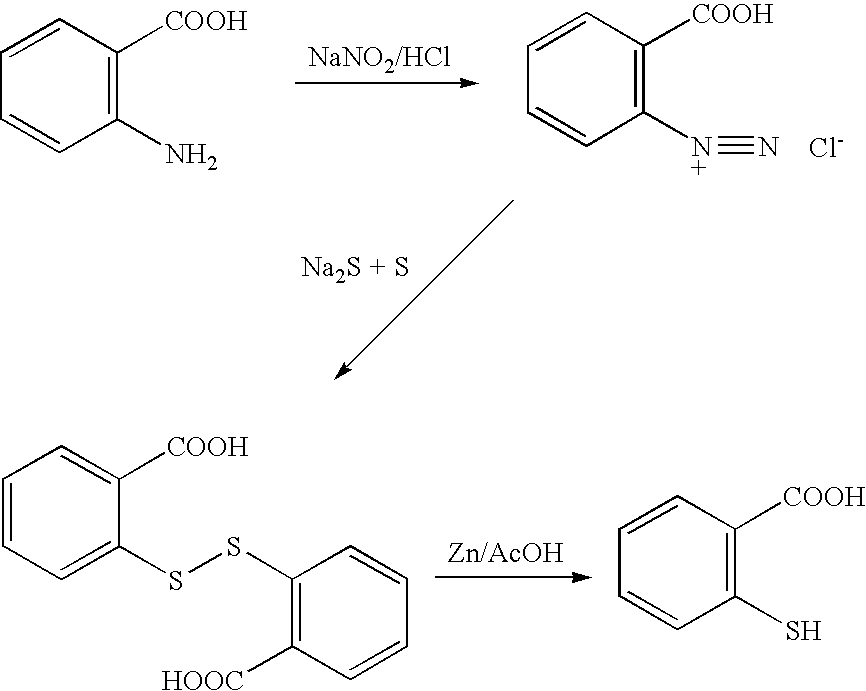Method for producing thiosalicylic acid
a technology of thiosalicylic acid and manufacturing method, which is applied in the field of manufacturing process of thiosalicylic acid, can solve the problems of reducing the efficiency of the process
- Summary
- Abstract
- Description
- Claims
- Application Information
AI Technical Summary
Benefits of technology
Problems solved by technology
Method used
Image
Examples
examples 2-6
[0025] Shown in Table 1 are results of a test conducted by following the same procedure as in Example 1 except that the ratio of sodium sulfide to sulfur and the amount of sodium sulfide were changed to those which are indicated in Table 1, respectively.
1 TABLE 1 Examples 1 2 3 4 5 6 Diazotization Anthranilic acid (mole) 0.10 0.10 0.10 0.10 0.10 0.10 Water (g) 41.1 34.3 34.3 36.7 34.3 34.3 35% hydrochloric acid (mole) 0.20 0.20 0.20 0.20 0.20 0.20 Sodium nitrite (mole) 0.105 0.098 0.105 0.105 0.105 0.105 Thiolization Sodium sulfide (mole) 0.09 0.08 0.11 0.10 0.095 0.12 Sulfur (mole) 0.02 0.02 Na / S (atomic ratio) 1.64 1.60 2.0 2.0 2.0 2.0 Sodium hydroxide (mole) 0.15 0.20 0.11 0.11 0.11 0.11 Water (g) 24.0 12.0 26.4 24.0 22.8 24.0 Diazotized mixture dropping <5 <5 <5 <5 <5 <5 temperature (.degree. C.) Thiosalicylic acid Yield by quantity (g) 15.5 14.3 14.6 14.4 13.9 14.8 Purity Thiosalicylic acid (wt %) 83.2 74.3 83.0 82.7 77.5 70.9 Dithiosalicylic acid (wt %) 2.6 0.3 1.4 2.7 11.6 1....
examples 7-12
[0026] Shown in Table 2 are results of a test conducted by following the same procedure as in Example 1 except that the amount of hydrochloric acid, the diazotized reaction mixture dropping temperature, the amount of sodium nitrite and the kind of mineral acid were changed to those which are indicated in Table 2, respectively.
2 TABLE 2 Examples 7 8 9 10 11 12 Diazotization Anthranilic acid (mole) 0.10 0.10 0.10 0.10 0.10 0.10 Water (g) 41.1 41.1 41.1 41.1 34.3 41.1 35% hydrochloric acid (mole) 0.15 0.20 0.20 0.20 0.20 0.15* Sodium nitrite (mole) 0.105 0.105 0.105 0.09 0.095 0.098 Thiolization Sodium sulfide (mole) 0.09 0.09 0.09 0.09 0.09 0.09 Sulfur (mole) 0.02 0.02 0.02 0.02 0.02 0.02 Na / S (atomic ratio) 1.64 1.64 1.64 1.64 1.64 1.64 Sodium hydroxide (mole) 0.15 0.15 0.15 0.15 0.10 0.20 Water (g) 24.0 24.0 24.0 24.0 13.7 12.0 Diazotized mixture dropping <5 20-30 55-60 20-30 20-30 20-30 temperature (.degree. C.) Thiosalicylic acid Yield by quantity (g) 15.5 14.2 14.0 12.9 14.0 14.1...
PUM
| Property | Measurement | Unit |
|---|---|---|
| Substance count | aaaaa | aaaaa |
| Fraction | aaaaa | aaaaa |
| Substance count | aaaaa | aaaaa |
Abstract
Description
Claims
Application Information
 Login to View More
Login to View More - R&D
- Intellectual Property
- Life Sciences
- Materials
- Tech Scout
- Unparalleled Data Quality
- Higher Quality Content
- 60% Fewer Hallucinations
Browse by: Latest US Patents, China's latest patents, Technical Efficacy Thesaurus, Application Domain, Technology Topic, Popular Technical Reports.
© 2025 PatSnap. All rights reserved.Legal|Privacy policy|Modern Slavery Act Transparency Statement|Sitemap|About US| Contact US: help@patsnap.com

